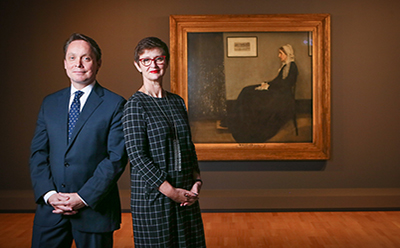 One of the world’s most iconic paintings, James McNeill Whistler’s Portrait of the artist’s mother, 1871, has been unveiled at the National Gallery of Victoria in its Australian debut.
One of the world’s most iconic paintings, James McNeill Whistler’s Portrait of the artist’s mother, 1871, has been unveiled at the National Gallery of Victoria in its Australian debut.
On loan from the Musée d’Orsay, Paris, and exhibited exclusively at the NGV in association with Art Exhibitions Australia, Whistler’s Mother explores the complex work from multiple perspectives to reveal the artist, the sitter, and the work’s immense artistic, social and historical impact.
“Alongside da Vinci’s Mona Lisa and Munch’s The Scream sits Whistler’s Portrait of the artist’s mother as one of a handful of artworks which enjoy universal recognition and admiration,” said Tony Ellwood, Director NGV. “We are grateful to the Musée d’Orsay for loaning us this most treasured item as part of a cultural exchange between the two institutions which will see the NGV’s renowned painting, Pierre Bonnard’s Siesta (La Sieste), 1900, loaned in return.”
Born in Massachusetts in 1834, James Abbott McNeill Whistler was an American-born painter, printmaker and designer during the Aesthetic movement, which celebrated ‘art for art’s sake’. Portrait of the artist’s mother was a pivotal moment in Whistler’s development as an artist and is today considered the most important American artwork to reside outside of the United States.
“Whistler’s Mother marks the first time that this large and imposing artwork has been exhibited in Australia, offering a unique opportunity for audiences to see a true masterpiece here in Melbourne,” said Dr Isobel Crombie, exhibition curator and Assistant Director NGV.
“This focused exhibition takes viewers on a journey through the history of the work, uncovering the life and career of Whistler; the life of the sitter, Anna Whistler; the artwork’s volatile reception; its conservation story; the influences that informed its production; and, its until now unexplored Australian connections, before viewers encounter the painting in a dedicated room.”
Regarded as a potent symbol of motherhood the atmospheric work depicts Whistler’s mother, Anna, sitting in profile clutching a white handkerchief, and is painted in tonal shades of grey and black. Anna’s stoic and pious personality can be read in contrast to her son, who was renowned for his flamboyant dress and famous social gatherings.
The painting drew criticism when it was first exhibited at the Royal Academy in London in 1872, with its abstract and non-narrative qualities confronting tastes of the time. By the end of the nineteenth century and into the early twentieth century, however, the painting had become a household name and drew crowds across Europe and the United States.
In 1934 Franklin Roosevelt, thirty-second President of the United States, was so taken with the austere portrait that he devised a design of it for a Mother’s Day stamp. Controversially, the stamp designer altered the image so that the mother was staring at a pot of flowers rather than into empty space, as in the original composition.
The NGV has its own associations with Portrait of the artist’s mother and holds an edition of the etching Black Lion Wharf, 1859, which is depicted in the background of the famous painting, and a similar Goodwin chair to the one which Anna Whistler sits on.
The exhibition also reveals the profound influence Whistler has had on some of Australia’s most prominent artists including John Longstaff, E. Phillips Fox and Hugh Ramsay. Whistler’s Mother explores the conservation story behind the work’s making and includes a short film, produced by the NGV, to further decode the significance of the work.
Whistler’s Mother
NGV International, 180 St. Kilda Road, Melbourne
Exhibition continues to 19 June 2016
Admission fees apply
For more information, visit: www.ngv.vic.gov.au for details.
Image: Tony Ellwood, Director NGV, and Isobel Crombie, Assistant Director NGV in front of Whistler’s Mother at NGV International – photo by Wayne Taylor
